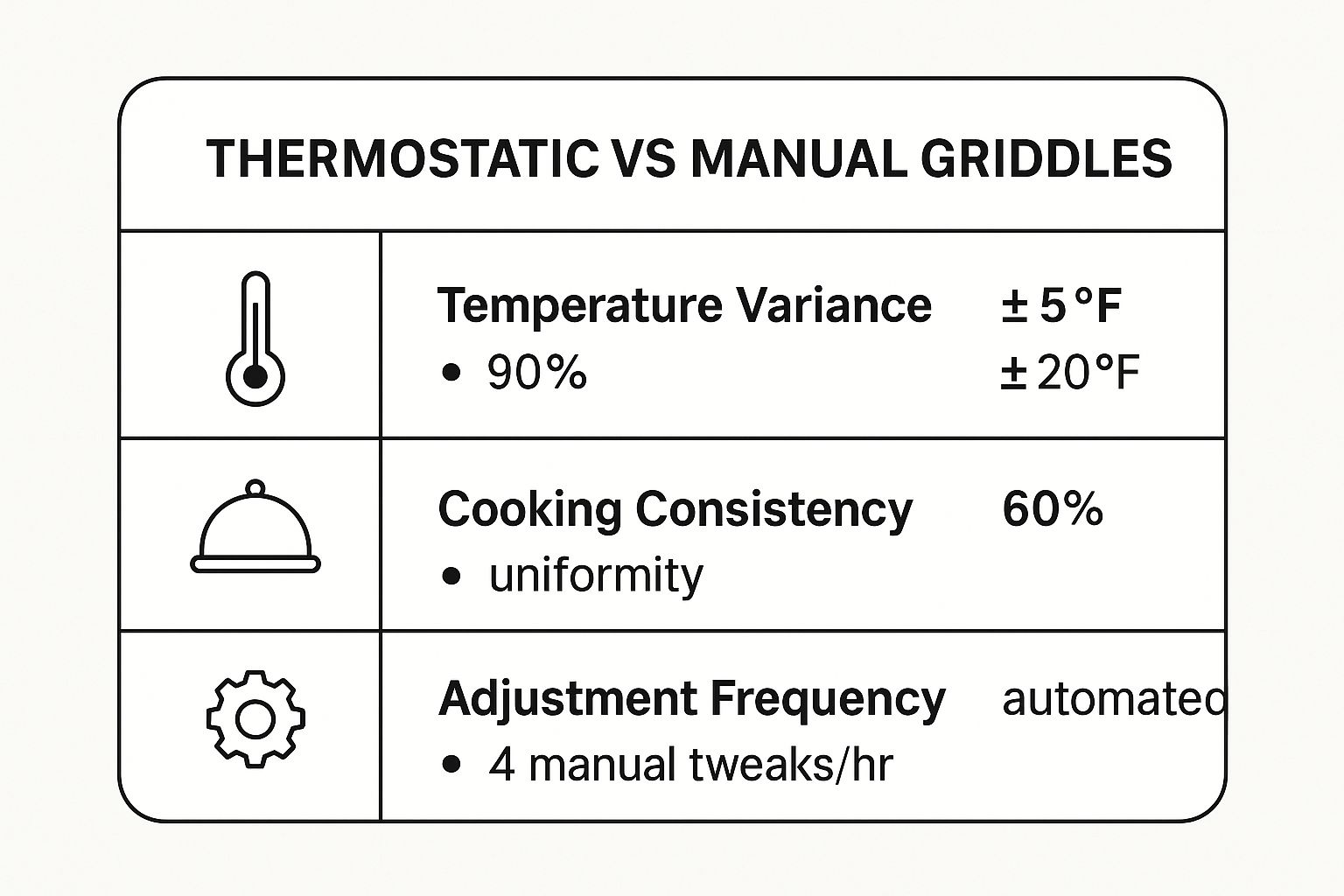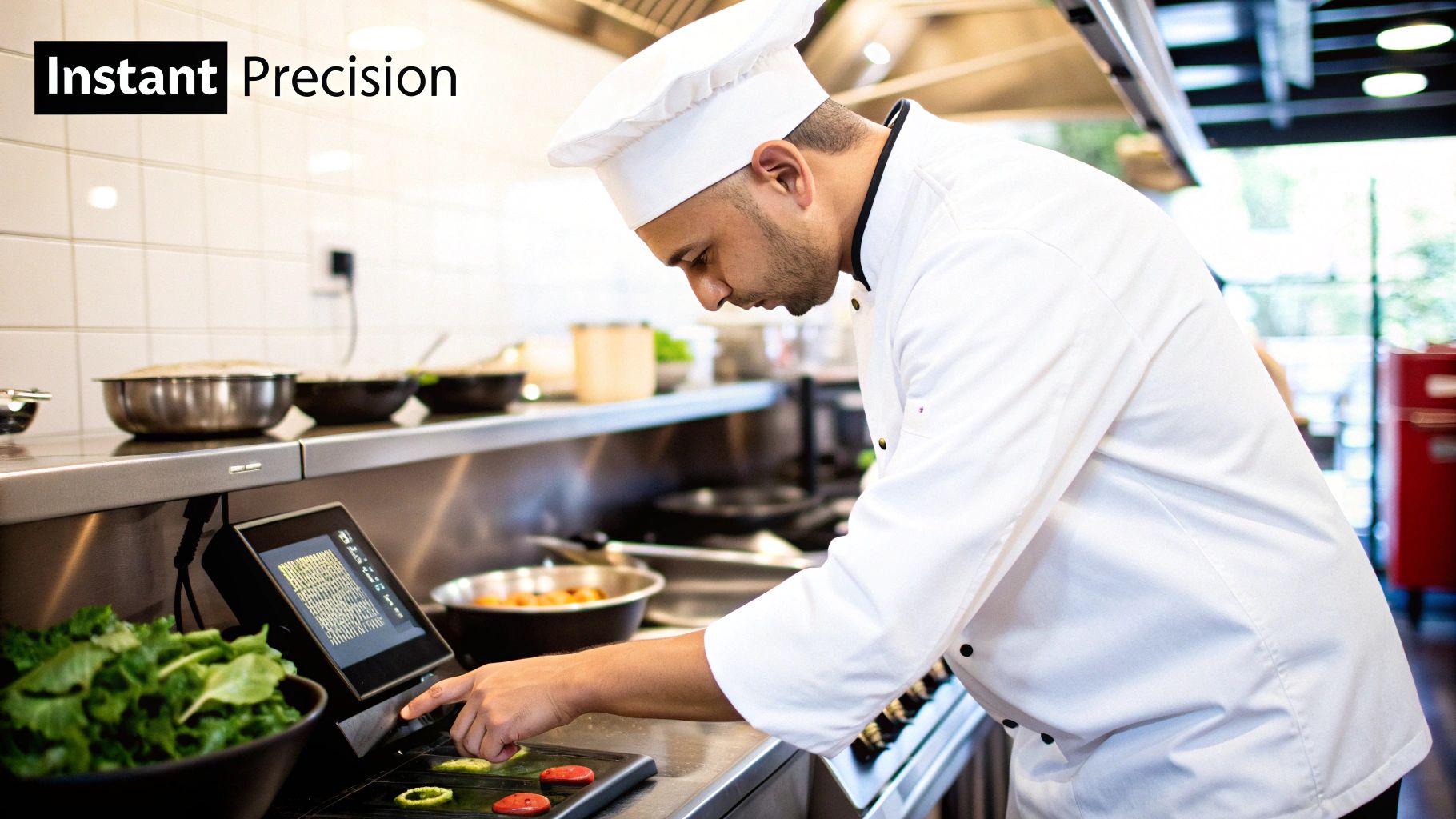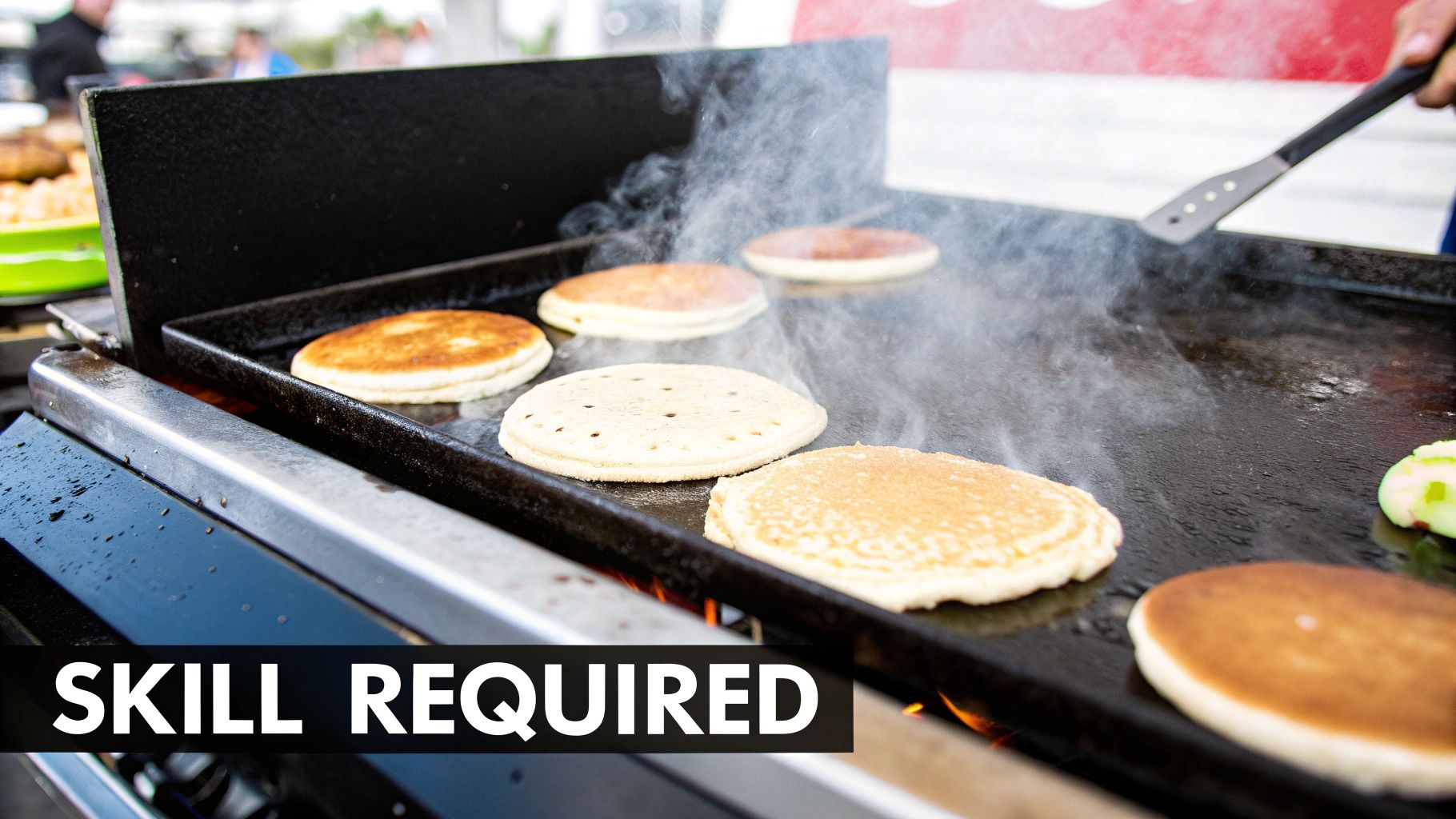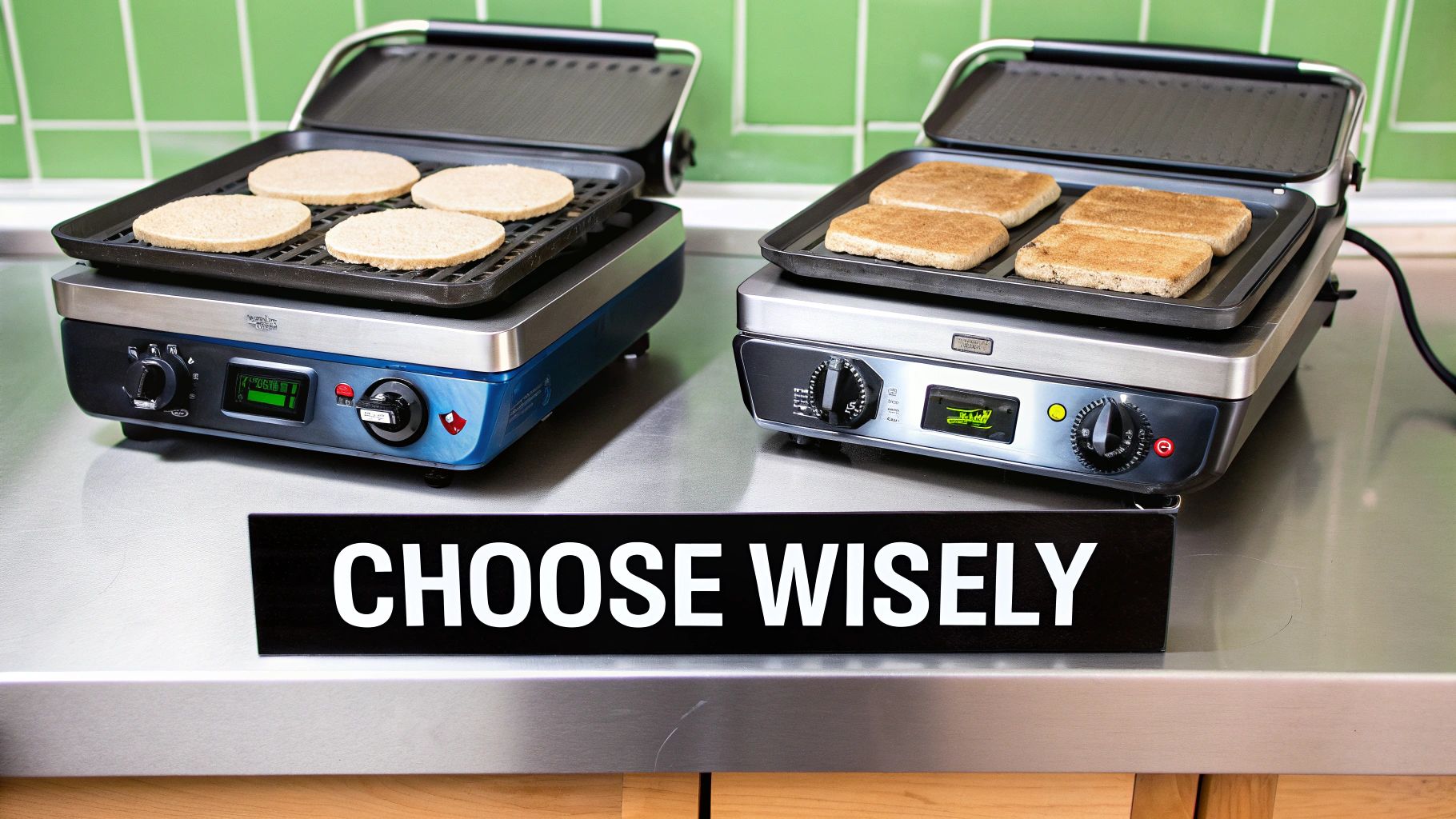
Thermostatic vs Manual Griddle: Choosing for Your Commercial Kitchen
When it comes to commercial griddles, the big debate always boils down to one thing: thermostatic vs. manual controls. The difference is all about precision and consistency. Think of a thermostatic griddle as having a built-in chef's assistant; its internal sensor automatically keeps the temperature exactly where you set it. On the other hand, a manual griddle puts you in the driver's seat, relying on your experience to manage the heat.
Choosing Your Commercial Griddle: An Executive Summary
Picking the right commercial griddle is more than just buying a piece of equipment. It's a decision that shapes your kitchen's workflow, the quality of every dish you send out, and how efficiently your team operates. This isn’t just about specs on a sheet; it's about matching the tool to the job.
If you're running a busy breakfast spot where every pancake and egg needs to be perfect, the pinpoint accuracy of a thermostatic unit is a game-changer. But for a craft burger joint that needs a screaming hot sear on one side and a gentle toast on the other, the zoned heating of a manual griddle might be the secret weapon.
This infographic breaks down the real-world performance gaps you'll see in temperature swings, cooking consistency, and how much hands-on attention each type demands.

As you can see, thermostatic griddles hold their temperature far more steadily, delivering uniform results without needing a cook to constantly babysit the dials.
At a Glance: Thermostatic vs. Manual Commercial Griddles
Getting a handle on these core differences is your first step. One griddle offers "set it and forget it" precision, while the other gives a seasoned chef raw power and direct control. Neither is flat-out better; their true value comes out in the context of your commercial kitchen.
This quick table cuts right to the chase, laying out the fundamental trade-offs you'll be making.
| Feature | Thermostatic Griddle | Manual Griddle |
|---|---|---|
| Temperature Control | Automated and precise; an internal thermostat holds the set temp. | Manual low, medium, and high settings give you direct control. |
| Best For | High-volume kitchens where consistency is key (e.g., eggs, pancakes). | Experienced chefs creating distinct heat zones for searing and warming. |
| Operator Skill Level | Lower skill friendly. The griddle does the temperature work for you. | Requires a skilled hand to manage temperature and avoid hot/cold spots. |
| Energy Efficiency | Typically more efficient because it cycles on and off as needed. | Can waste energy if left cranked on high when not in full use. |
Ultimately, this side-by-side view helps frame the decision: Are you optimizing for consistency and ease of use, or for versatility and chef-driven control? Your answer will point you to the right griddle.
How Each Commercial Griddle Control System Works

To really get to the bottom of the thermostatic vs. manual griddle debate, you have to understand how each one actually works. They both get hot and cook food on a flat top, but how they manage that heat is a night-and-day difference. That core design choice impacts everything from food quality to how smoothly your kitchen runs during a rush.
A thermostatic griddle operates with precise control. You dial in a specific temperature—let's say 350°F—and an internal thermostat does the rest. This little sensor is constantly reading the temperature of the griddle plate.
When you throw a bunch of cold burger patties on the surface and the temperature dips, the thermostat senses it and kicks the burners on full blast. Once it's back up to your target temp, the burners cycle off. This constant on-and-off cycle is the secret to its precision.
The Precision of Thermostatic Controls
The real win with an automated system like this is consistency. A thermostatic unit handles the temperature management for you, which means the last pancake of the breakfast rush gets cooked at the exact same temperature as the first. For delicate items or commercial kitchens with newer cooks, that kind of precision is a game-changer.
This reliability is why you see them everywhere. While the choice always depends on the kitchen's needs, commercial operations across North America, Europe, and Asia often lean on thermostatic models to keep things consistent during high-volume service.
Key Takeaway: A thermostatic griddle is built for repeatability. It takes the guesswork out of temperature control, giving you predictable results that are perfect for standardized menu items and hectic service times.
For a deeper look at how these automated systems can streamline your kitchen, check out our guide on the benefits of a thermostatic griddle. It's all about ensuring food safety and quality with less hands-on effort.
The Direct Power of Manual Controls
On the other hand, a manual griddle gives you a much more direct, hands-on experience. Forget a precise temperature dial; you get simple knobs, usually with low, medium, and high settings for different sections of the griddle. There's no sensor—the heat output is 100% up to the operator.
An experienced line cook uses these settings to create different heat zones across the flat top. This is a classic technique that lets them juggle multiple tasks at once. For instance, they might have one section cranked to "high" for a hard sear on a steak, while the "low" zone next to it is gently toasting buns or melting cheese.
This method takes skill and constant awareness. The cook has to learn the personality of their griddle—where the hot spots are, how it recovers—and make adjustments on the fly based on sight, sound, and feel. It’s a system built for flexibility and a chef's creativity, not set-it-and-forget-it precision.
Comparing Performance and Temperature Control
When the lunch rush hits, your griddle’s performance is everything. It directly impacts ticket times, food quality, and the overall stress level in your kitchen. The real difference between a thermostatic and a manual griddle isn't just about holding a temperature; it's about accuracy, recovery, and how each one handles the pressure. These factors decide if your griddle is a reliable workhorse or a constant headache.

A thermostatic griddle is built for precision. It works by cycling its burners on and off to keep the cooking surface within a super-tight temperature window, often just ±10-15°F of your set point. For delicate foods like pancakes or eggs, that kind of accuracy is non-negotiable. A small temperature swing can be the difference between golden-brown perfection and a burnt mess.
This level of control is the key to menu consistency, especially for high-volume diners or institutional kitchens. When every single order needs to be cooked exactly the same, a thermostatic unit takes the guesswork out of the equation and makes it easier to train new cooks.
The Power of Zoned Heating on a Manual Griddle
On the other hand, a manual griddle is all about direct, hands-on control. There's no thermostat enforcing one uniform temperature. Instead, a skilled chef can turn a single flat top into a multi-temperature cooking landscape, and that's its biggest advantage.
Think about a busy smash burger station. A cook can crank one section to high for that perfect, crusty sear on the patties. At the same time, an adjacent section can be set to low for gently toasting buns, while a middle zone holds cooked burgers at a safe temp. It's a beautifully efficient workflow.
You simply can't do that on a standard thermostatic griddle, which is designed to maintain one consistent temperature across the board. The manual griddle gives a seasoned pro the power to juggle multiple tasks at once, boosting both efficiency and creativity.
A thermostatic griddle delivers menu consistency, while a manual griddle empowers chef creativity.
Heat Recovery Under Pressure
Another huge performance factor is heat recovery. How fast does the griddle get back to temperature after you slap down a dozen frozen burger patties? That sudden temperature drop can be a killer, turning a beautiful sear into a steamed, grey disappointment if recovery is slow.
Generally, high-end thermostatic griddles with embedded sensors react instantly, firing up the burners to climb back to the set temperature quickly. This ensures you get consistent results, even when you're slammed. Manual griddles, however, depend entirely on the operator. A good cook will anticipate the temp drop and adjust the dials, but the recovery can be less precise and consistent.
The market definitely shows a strong preference for reliable, predictable performance. Thermostatic electric griddles, prized for their exact temperature control, make up a huge piece of the global market, with annual sales hitting around $1.5 billion. This tells you just how much commercial kitchens value consistent results. You can find more data on the global electric griddle market on MarketReportAnalytics.com.
Ultimately, the right choice comes down to your menu and your kitchen's style. A breakfast spot churning out hundreds of eggs and pancakes will thrive with the unwavering consistency of a thermostatic griddle. But a dynamic, chef-driven kitchen might find the raw power and flexibility of a manual unit to be absolutely essential.
Analyzing Total Cost and Operational Impact
When you're trying to decide between a thermostatic and a manual griddle, looking at the sticker price is just scratching the surface. The real story unfolds when you dig into the total cost of ownership—that’s where you see the long-term impact on your budget, energy bills, and even your kitchen staff.

Manual griddles almost always have a lower upfront cost. It makes sense; their design is simpler with fewer complex parts, which naturally brings the purchase price down. For a new commercial kitchen on a tight budget, that initial saving can look mighty tempting, but it can be a bit of a trap if you’re not thinking about the ongoing expenses.
Long-Term Energy Efficiency
Here’s where the numbers really start to diverge: energy consumption. A thermostatic griddle is built from the ground up for efficiency. Its internal thermostat is constantly working, cycling the heat on and off to maintain a precise temperature. It only draws full power when it absolutely needs to, which can translate into serious savings on your utility bills over the years.
On the flip side, a manual griddle is often left running at a steady setting throughout a service, burning through energy whether you're cooking on it or not. That’s a lot of wasted energy, especially during those lulls between the breakfast and lunch rush. Your fuel choice matters here, too. For a deeper dive, check out our guide comparing natural gas vs propane for commercial kitchens.
Key Insight: Don’t be fooled by the lower initial price of a manual griddle. Those savings can get eaten up pretty quickly by higher energy bills. For high-volume kitchens where efficiency is king, a thermostatic model is often the smarter long-term investment.
To give you a clearer picture of how these costs add up over time, we've broken them down side-by-side.
Total Cost of Ownership Breakdown
| Cost Factor | Thermostatic Griddle | Manual Griddle |
|---|---|---|
| Initial Purchase Cost | Higher initial investment due to more complex components like thermostats and sensors. | Lower upfront cost, making it attractive for budget-conscious startups. |
| Energy Consumption | Significantly more efficient; cycles on and off to maintain temperature, reducing energy waste. | Consumes energy continuously when on, leading to higher utility bills, especially if left idle. |
| Labor & Training | Lower training curve. "Set-and-forget" operation allows less experienced staff to achieve consistency. | Requires a skilled operator with a "feel" for the equipment, potentially leading to higher labor costs. |
| Food Waste | Precise temperature control reduces the risk of burning or undercooking, minimizing waste. | Higher potential for inconsistency and food waste, especially with inexperienced cooks. |
| Maintenance & Repair | More complex parts could mean potentially costlier repairs if the thermostat fails. | Simpler mechanics often lead to cheaper and easier repairs for common issues. |
As you can see, the decision isn't just about the price tag. It's about balancing upfront savings against long-term operational costs that will affect your bottom line for years to come.
The Hidden Cost of Labor and Training
Another factor that often gets overlooked is the impact on your team. Thermostatic griddles are a game-changer for training new staff. You set the temperature, and the griddle does the heavy lifting. This frees up your seasoned chefs to handle more demanding tasks instead of babysitting the flat top.
A manual griddle, on the other hand, really demands an experienced hand. A good cook knows how to work with its quirks—the hot spots, the recovery time—to get consistent results. That reliance on skill can be a hidden cost, whether it's paying higher wages for top talent or dealing with inconsistent food and waste from a greener crew. Think about your staffing model; it’s a huge piece of this puzzle.
Matching the Griddle to Your Kitchen's Needs
Knowing the tech specs of thermostatic vs. manual griddles is one thing, but figuring out which one actually belongs on your line is a whole different ball game. The right choice really boils down to your menu, your crew's experience level, and the specific hustle of your kitchen. This is where the rubber meets the road.
This decision isn't just a simple feature comparison; it's about matching the tool to your daily reality. A griddle that's a workhorse in a slammed diner could be totally wrong for a small, chef-driven bistro. Let's walk through a few real-world scenarios to see where each griddle really proves its worth.
The High-Volume Diner and Institutional Kitchen
Picture a classic American diner on a Sunday morning. The ticket rail is full of orders for pancakes, eggs, bacon, and hash browns. In a chaotic environment like that, consistency is king. Every single pancake needs to hit the plate with that perfect golden-brown color.
This is the sweet spot for a thermostatic griddle. Because it holds a precise temperature within a tight range (±10-15°F), you get predictable, high-quality results even if you have less experienced cooks running the station. The "set it and forget it" control lets your staff focus on getting plates out fast instead of constantly fiddling with the dials.
- Recommendation: Thermostatic Griddle
- Justification: It guarantees menu consistency, makes it easier to train new hires, and cuts down on food waste from burnt or undercooked items.
The same logic holds true for places like hospital or school kitchens, where food safety and standardized results are absolutely critical.
A thermostatic griddle is really an investment in your kitchen’s stability. It takes temperature guesswork out of the equation, letting you scale up production without sacrificing quality.
The Gourmet Burger Spot and Steakhouse
Now, think about a gourmet burger joint that’s famous for its incredible sear. The chef needs one part of the griddle screaming hot for that perfect smash burger crust, while another part is gently toasting brioche buns. That means you need different heat zones on the same flat top.
This is where a manual griddle becomes the chef's best friend. A skilled cook can dial in the high, medium, and low settings to create distinct cooking zones. One area can deliver the intense heat needed for searing proteins, while another provides a gentle holding temperature.
- Recommendation: Manual Griddle
- Justification: It gives an experienced chef total flexibility for zoned cooking, making it easy to multitask and dial in the perfect sear.
For steakhouses and other chef-driven spots, a manual griddle offers a hands-on level of control and creativity that a single-temp thermostatic unit just can't deliver.
Catering Operations and Food Trucks
Caterers and food trucks have their own unique headaches. Menus can change daily, and they need versatile equipment that can perform in very tight quarters. One day it's hundreds of identical breakfast burritos; the next, it's custom-seared items to order.
The choice here isn't so black and white; it really depends on the menu. A food truck slinging Philly cheesesteaks would get great use out of a manual griddle's zoned heating. On the other hand, a caterer who needs to knock out massive batches of flawless pancakes for a wedding brunch will find a thermostatic model far more reliable. You've got to take a hard look at your most common and profitable dishes to make the right call.
Frequently Asked Questions About Commercial Griddles
Even after breaking everything down, you probably still have a few questions. That’s normal. Choosing between a thermostatic and a manual griddle is a big deal for any commercial kitchen, and the small details can make all the difference down the road.
Let's clear up some of the most common questions we hear from chefs and operators before they make their final pick.
Which Griddle Type Is Easier To Maintain and Clean?
When it comes to daily wipe-downs and scraping, they’re pretty much identical. Your cleaning routine is dictated by the griddle plate material—steel or chrome—not the control type. Daily scraping, a good scrub with a griddle brick, and proper seasoning are essential for either one to last.
The real difference shows up when something breaks. A thermostatic griddle has more complex internal electronics. If that thermostat goes, you’re likely calling in a specialized technician. On the other hand, the mechanical knobs and valves on a manual griddle are far simpler, making repairs generally faster and less costly.
Can a Manual Griddle Be Used for Delicate Foods?
Absolutely, but it takes a seasoned pro. A great line cook knows their manual griddle like the back of their hand. They can pinpoint the cooler spots on the surface that are perfect for holding a steady, low temperature for things like eggs or delicate fish.
The catch? This method leans entirely on the chef's skill and constant watchfulness. During a chaotic dinner rush or with a less experienced crew, you’re gambling with consistency. A thermostatic griddle just eliminates that risk, making it the safer bet for kitchens that need every dish to be perfect, every time.
Key Takeaway: While a skilled chef can cook anything on a manual griddle, a thermostatic model provides a built-in "safety net." It guarantees consistent temperatures, cutting down on food waste and protecting your reputation for quality.
Is There a Difference in Lifespan Between These Griddles?
Honestly, the lifespan of your griddle has far more to do with the build quality and how well you take care of it than whether it's manual or thermostatic. A heavy-duty unit from a reputable brand will last for decades with the right maintenance, regardless of the control style.
The parts that fail are just different. On a thermostatic griddle, the thermostat itself is the main component that might need replacing over the years. For a manual unit, it's usually the control knobs or the gas valves that wear out. If you invest in quality construction from the start, either type will be a workhorse in your kitchen for a long, long time.
Does This Choice Apply to Gas Griddles Too?
Yes, the core differences between thermostatic and manual controls are exactly the same whether you're running on gas or electric. The technology just works a little differently depending on the power source.
A thermostatic gas griddle uses its sensor to automatically raise or lower the flame to hold the temperature you've set. A manual gas griddle gives the chef direct control over the flame with a simple high-to-low valve. All the trade-offs we've talked about—precision versus raw power, energy savings, and staff training—apply equally to both.
Ready to find the perfect griddle for your kitchen? At Griddles.com, we stock a huge selection of high-performance thermostatic and manual griddles built to handle the heat of any commercial kitchen. Explore our collection of commercial griddles at Griddles.com and get free shipping and expert advice to make the right choice for your business.
